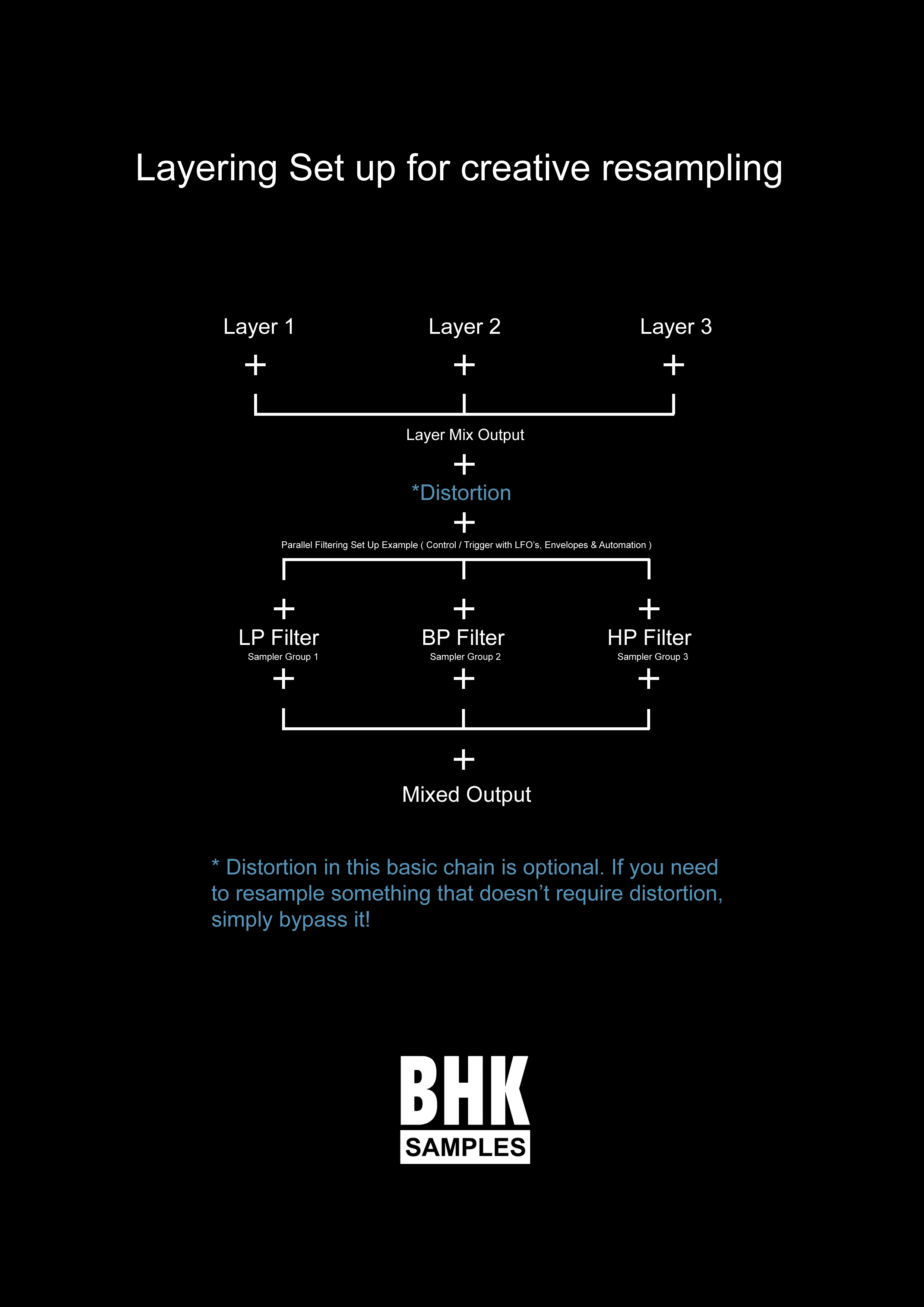
Editing Reese Bass Oneshots
When resampling sounds, using a sampler is often more effective than processing them directly on an audio track with effects. The advantage of a sampler is that it allows you to play samples like an instrument, while also enabling real-time modulation and effects. This approach helps you quickly generate numerous building blocks that can later be assembled into a complex-sounding sequence.
Many assume that intricate basslines are created through extensive automation, but in most cases, they are simply individual processed sample snippets arranged in sequence until something compelling emerges. While the following techniques can yield interesting results, assembling a grooving, complex bassline remains a puzzle—one that can involve significant automation work.
However, the creative process is highly flexible: we have LFOs, envelopes, and automation to shape movement in any way we desire.
Using Samples as a Foundation for New Textures
Granular Synthesis
One of the simplest ways to experiment with new textures is by using synthesizers that offer granular processing. You don’t need an in-depth understanding of each synth—just try out factory bass presets and swap out the factory samples with ones from your own library. If the preset settings alter the sample in an interesting way, save the preset or resample sustained one-shots in the key that sounds best. These don’t necessarily have to be the common notes with the most low-end!
Layering
Layering is a fundamental technique for customizing the tone and texture of a sound. For example to thicken up a sample, create a parallel channel for the sample, apply an EQ or filter, and cut out the highs and mids, leaving only the low-end. Then, blend this layer into the mix by adjusting its volume balance.
If the low-passed sample lacks sufficient low-end energy, consider reinforcing it with an extra sine wave bass layer.
In this audio example below, we’ll demonstrate the simplest way to layer Reese basses to create a new texture. The mix is achieved purely through volume balancing.
Example Reese Bass Layering:
0:00 Reese Layer 1 I 0:04 Reese Layer 2 I 0:08 Reese Layer 3 I 0:12 Reese Layer 1 & 2 Mix I 0:17 Reese Layer 1, 2 & 3 Mix
Altering the Sound with Distortions & Waveshaper
Next way, and most common way to customize the sound is by applying distortion. Distortion generally yields better results when applied to samples with a strong low-end presence rather than those focused in the midrange. However, if a sample lacks low-end, you can compensate by layering it with a sub-bass. The balance between elements—such as the midrange bass and the sub-bass layer—plays a crucial role in shaping the distortion process and the final texture.
Example Distortion:
Midrange Reese
Midrange Reese & Subbass Layer Mix
Midrange Reese & Subbass Layer Mix Distorted
Parallel Waveshaping
Another way to shape or intensify Reese basses is through parallel waveshaping. This technique involves routing the sound through two or three different waveshaper effects in parallel and then blending them together. Each layer is filtered with a low-pass before the waveshaper to isolate and process the low, mid, or high frequencies individually. Keep in mind that the overall tonal character of the mix largely depends on how you balance the volume of each layer. For example, if the processed midrange or high-end layer becomes too dominant, simply lower its volume.
Source Sample:
The first layer receives distortion focused on the low end, adding weight and power to the bass.
The second layer is distorted in the midrange, where the characteristic “snarl” or growl of the Reesebass typically emerges.
The third layer targets the high end, adding presence, sharpness, and texture.
After processing, the layers are recombined through careful leveling to create a cohesive yet powerful sound.
Effect Processing Approaches
At its core, effect processing follows two fundamental approaches, which can be used separately or combined:
- Serial Processing – Effects are applied in a chain, one after another.
- Parallel Processing – The signal is split, processed in separate ways, and then mixed back together.
Parallel processing offers greater flexibility, allowing for more intricate effect chains and creative possibilities compared to serial processing.
Creating Movement in Sounds
The primary tools for adding movement to sounds are ADSR or AHDSR envelopes, LFOs, and automation. Many effects can make sounds more dynamic and lively, but filtering is particularly effective for creating movement.
You can use either serial or parallel filtering. If you want to create morphing or organic sounds, the parallel approach is often more effective. However, there are also serial filters—often referred to as morphing filters, Z-plane filters, or multi-filters—that effecting internally parallel aswell.
Tip: When using LFO’s to modulate filters, set the LFO’s into retrigger mode to hear the LFO modulation of all filters clearer!
Example Parallel Filtering
This audio example starts with the unfiltered Reese bass, followed by LFO-modulated low-pass, band-pass, and high-pass filter layers. And finally, all three filtered layers together in the mix.
Example Parallel Filtering:
0:00 Unfiltered Reese I 0:06 Lowpass Filter Layer I 0:11 Bandpass Filter Layer I 0:17 Highpass Filter Layer I 0:22 Filter Layer Mix
Example Serial Filtering
By combining falling pitch modulation with formant filtering, you can transform any low- to mid-range reese bass into a deep, aggressive growl sound.
Tip: Experimenting with different filter types on a variety of textures serial or parallel is key to understanding how they shape and interact with sound.
Over time, you’ll develop a feel for which filters are best suited for specific tasks—whether it’s shaping bass, adding movement to pads, or sculpting drums.
Example Effect Chain
Below is an example of an effect chain that you can recreate in any DAW, using instrumnet and effekt racks as well as implement with hardware samplers using groups. This way, you can seamlessly switch between serial and parallel processing as needed.
If the entire chain isn’t possible with your tools, break the process into steps: first, create textures, then sample them as one-shots, and finally, add movement using modulation effects.
The + symbols between the signal paths (image below) are just suggestions for where additional effects could be inserted within this main chain—between layering, distortion, and parallel filtering—to further shape the sound.
We hope this tutorial has inspired you to experiment more with resampling over more than one lane.
Happy resampling!

